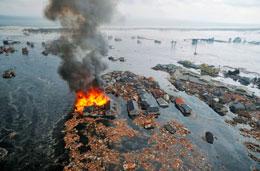Our Passion is 2 Reach Our Individual and Collective Potential 4 Excellence & Success-Always!
Published online 11 March 2011 | Nature | doi:10.1038/news.2011.156
News
More earthquakes expected in Japan
Big quake could be part of a string of aftershocks, say geologists.
 The earthquake caused devastating tsunamis along the Japanese coast.KYODO / REUTERS
The earthquake caused devastating tsunamis along the Japanese coast.KYODO / REUTERSAt least 200 people have died in Japan, in what seems to have been the most powerful and devastating earthquake in the tremor-rich country since records began around 50 years ago. The quake has left the nation in a state of shock, and geologists warn that the seismic risk remains high.
The Japanese government declared an emergency following the magnitude-8.9 earthquake that struck today at 14:46 local time near the east coast of Honshu Island.
Five nuclear power stations in the quake region have automatically shut down, and around 2,000 people living near the Fukushima nuclear plant in Okuma were advised to evacuate after the water-based cooling system for one of the plant's reactor cores failed, according to a statement from the Japan Atomic Industrial Forum, an industry trade group. The statement said that sufficient water remained to cover the core, and that emergency generators were being rushed to the site to restart the cooling system.
Evacuations were also ordered in coastal communities in Hawaii, the Philippines and other countries with Pacific coasts, which had been alerted about the approaching tsunami.
Geologists suspect that today's quake was actually an aftershock of a much weaker magnitude-7.2 quake on 9 March. They warn that seismic stress has not yet relaxed in some particularly vulnerable parts of Japan, including the Tokyo region, 400 kilometres south of today's epicentre.
Both quakes are the result of the Pacific tectonic plate sliding beneath the Japanese islands. At eight centimetres per year, convergence along this subduction zone is extremely fast in geological terms.
Increased stress
"Although certainly very big, today's quake was not totally unexpected," says John McCloskey, a geophysicist at the University of Ulster in Coleraine, UK. "Technically, it was in fact an aftershock of the weaker quake earlier in the week — even though it may sound odd that an aftershock can be stronger than the main shock."
 The magnitude-8.9 quake hit just east of Sendai. Click for a larger image.
The magnitude-8.9 quake hit just east of Sendai. Click for a larger image.McCloskey's group had just completed computer calculations of the changes in seismic stress caused by the 9 March quake when the big one struck. They quickly detected the seismic causality between the two events.
"The previous quake, although much smaller, significantly increased stress in the fraction of the fault zone that ruptured today," says McCloskey.
The sequence of quakes has probably also affected the stress field further south along the fault zone, critically increasing the earthquake risk in the Tokyo region, he says.
"There is a strong interaction of quakes along a subduction zone, and we can certainly expect a number of major aftershocks in the next weeks," he says. "Some may be as large as, or even stronger than, the quake that last month devastated Christchurch in New Zealand. And chances are that another very large shock could occur to the south near Tokyo."
Today's quake seems to have abruptly displaced the seafloor off Japan by a few metres, which caused the tsunami.
"This was the largest tsunami ever measured by US National Oceanic and Atmospheric Administration tsunamographs in the open ocean, with maximum crest height of over 2 metres," says Costas Synolakis, director of the University of Southern California's Tsunami Research Center in Los Angeles.
According to local reports, the tsunami reached up to 10 metres in height when it hit Japan's Sanriku coast barely 30 minutes after the quake. Along flat coasts, the tsunami propagated hundreds of meters inland, sweeping away homes, cars and roads. Sendai airport was completely flooded. The number of people killed in the tsunami is as yet unclear, but reports suggest it could be several hundred.
"Sanriku is probably the best-prepared coast in the world," says Hermann Fritz, a tsunami expert at the Georgia Institute of Technology in Savannah. "But I am afraid it was not enough, despite tsunami gates and vertical evacuation structures and signs and everything else."
Thanks to the wave's long travelling time across the Pacific Ocean, and the existence of a sophisticated tsunami early-warning system in the region, the water seem to have caused no casualties or major damage anywhere else around the Pacific.]
A Pacific-wide tsunami last occurred after a magnitude-8.8 earthquake that killed 521 people in Chile in February 2010. And on 26 December 2004, a tsunami triggered by a record 9.2 quake off Sumatra in Indonesia killed more than 220,000 people around the Indian Ocean region.
Comments
If you find something abusive or inappropriate or which does not otherwise comply with our Terms or Community Guidelines, please select the relevant'Report this comment' link.
Comments on this thread are vetted after posting.
Add your own comment
This is a public forum. Please keep to our Community Guidelines. You can be controversial, but please don't get personal or offensive and do keep it brief. Remember our threads are for feedback and discussion - not for publishing papers, press releases or advertisements.
You need to be registered with Nature to leave a comment. Please log in or register as a new user. You will be re-directed back


Dr. Shruti Chauhan
Dr. Akhilesh Kumar Singh
Dr. Parul Chauhan
It`s possible a correlation between Solar magnetic shocks and the quakes ?
The floods have a link with El Niño ? La Niña, and boths with water temperature, and higs temperatures with fails in the ocean layer, and those fails with tectonics plates in movement. Ask again : the Earth is crcking ?
Major earthquakes
Main article: List of earthquakes
One of the most devastating earthquakes in history occurred on 23 January 1556 in the Shaanxi province, China, killing more than 830,000 people . Most of the population in the area at the time lived in yaodongs, artificial caves in loess cliffs, many of which collapsed during the catastrophe with great loss of life. The 1976 Tangshan earthquake, with death toll estimated to be between 240,000 to 655,000, is believed to be the largest earthquake of the 20th century by death toll.